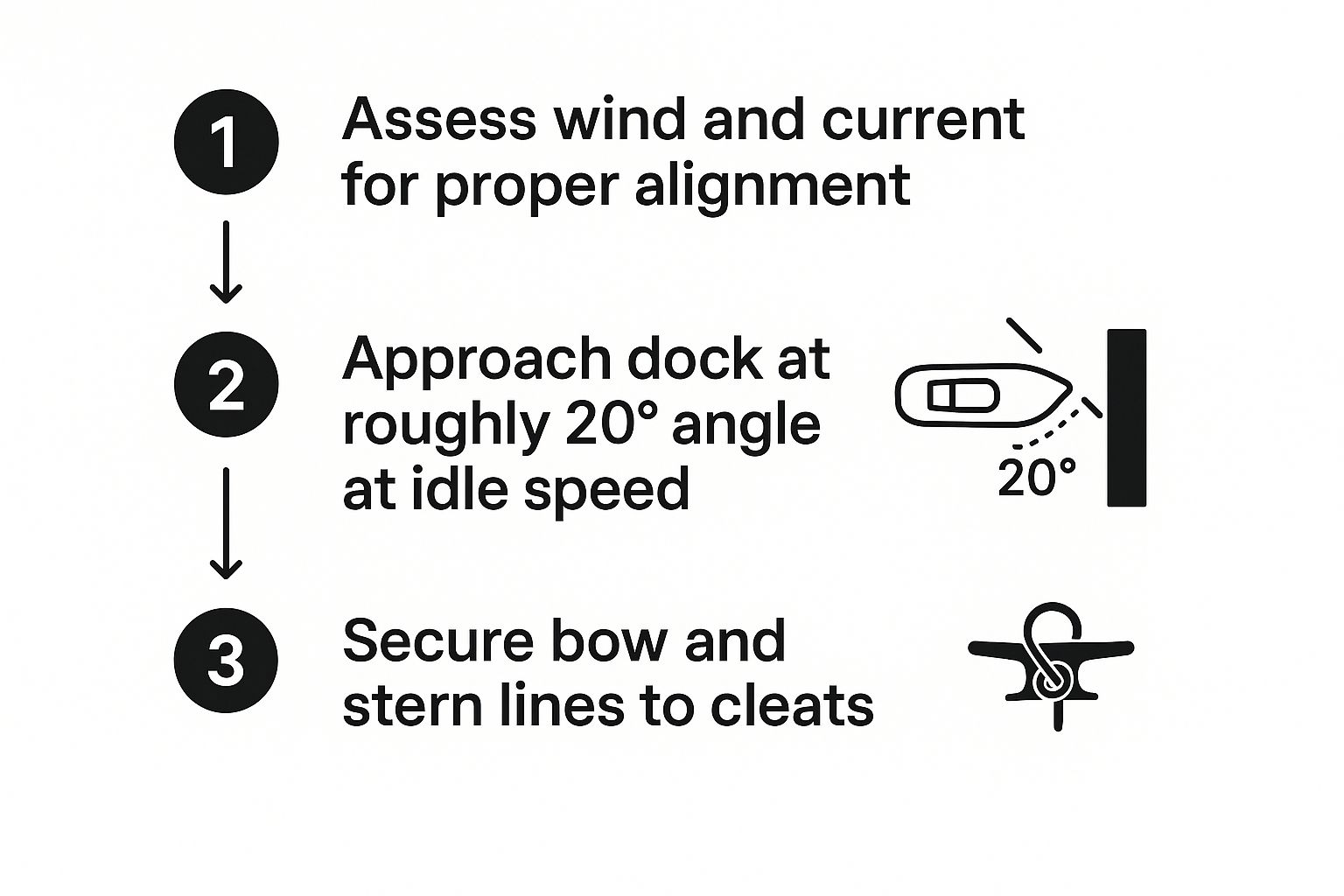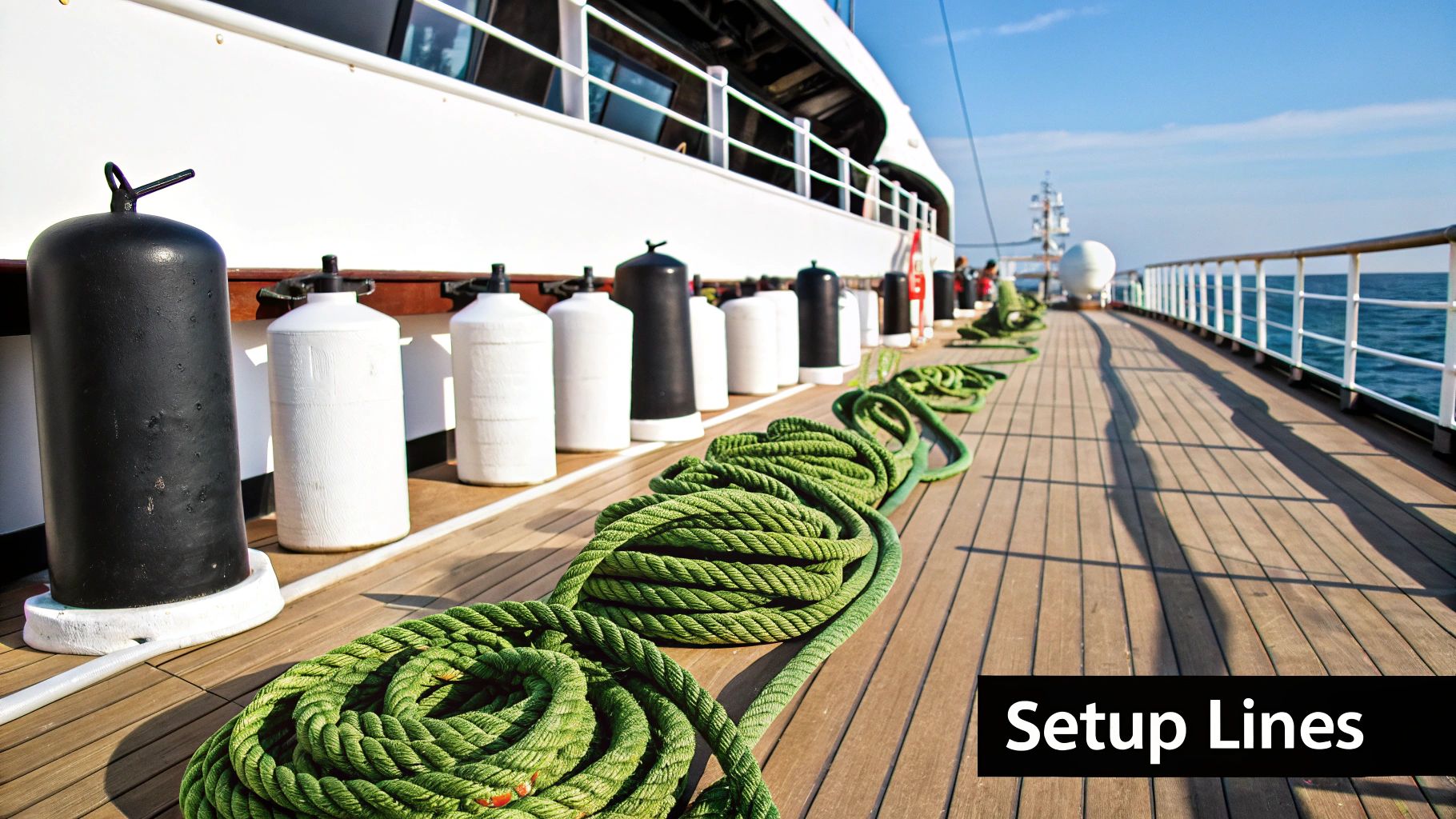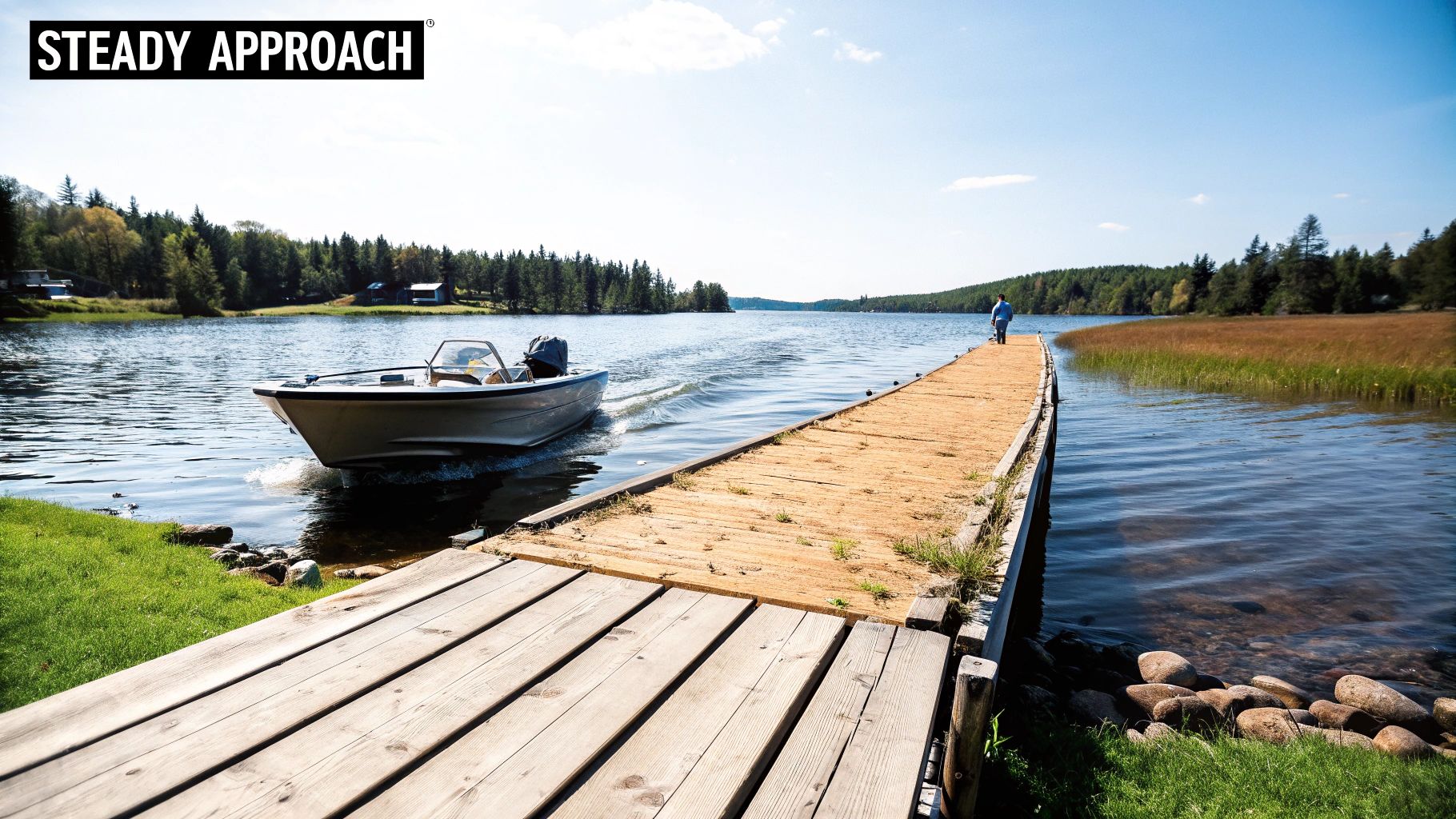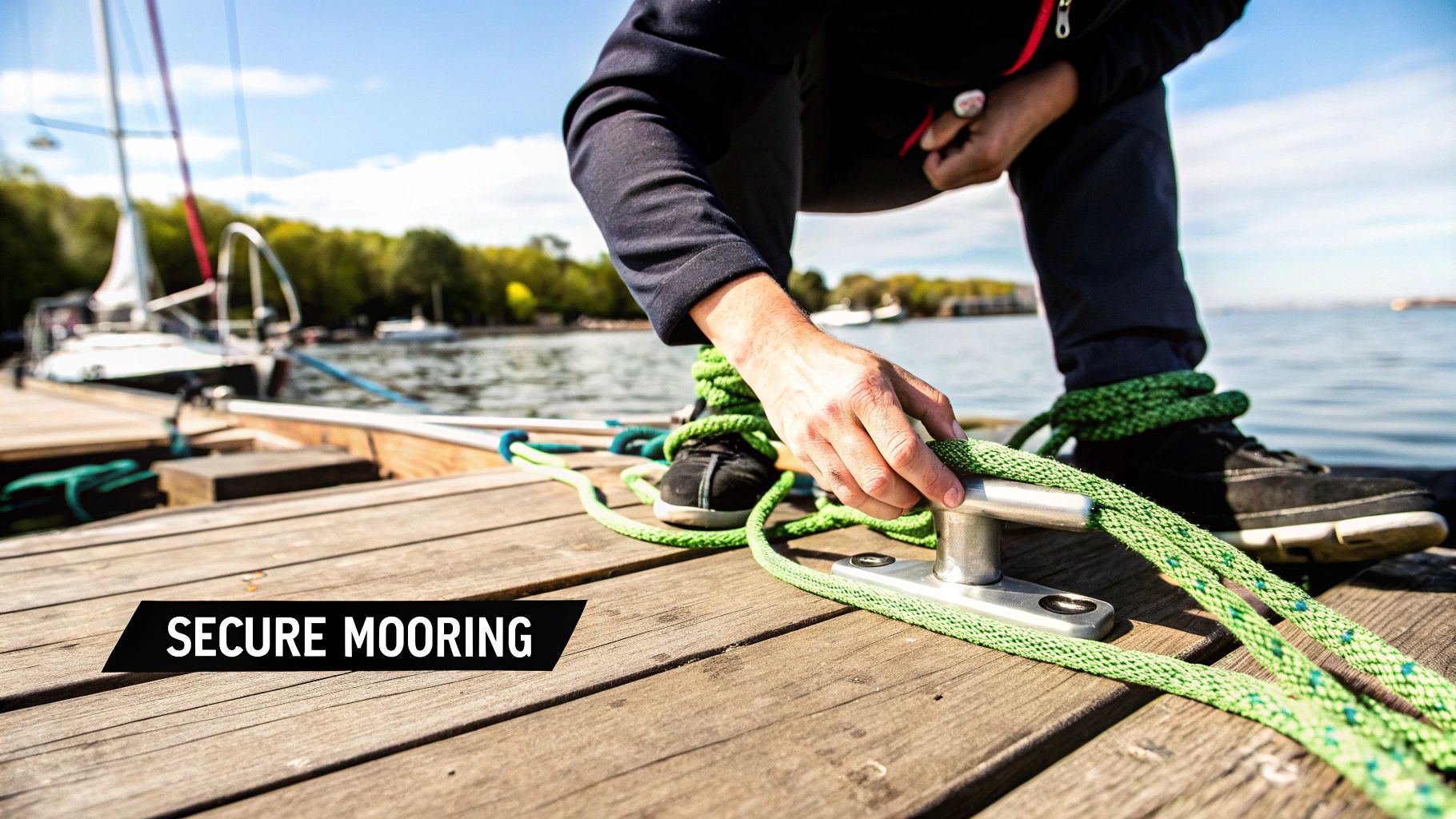How to Dock a Boat Like a Pro
I've seen it a thousand times at the marina: a beautiful day on the water ends with a stressful, high-stakes scramble to get tied up. Shouting, fumbling with lines, and the dreaded thump of hull against pier. The secret to avoiding all that drama isn't some fancy piloting trick—it’s about what you do before you even get close to the dock.
A smooth, controlled landing is 90% preparation and 10% execution. When you take a few minutes to get everything set up, a potentially tense situation becomes a calm, predictable maneuver.
Master Your Docking Before Leaving the Slip
The best time to practice docking is actually when you're leaving. Think about it: you're already at the dock, your lines are set, and you can see exactly how the wind and current are affecting your boat. Take a moment to observe before you cast off. This mental rehearsal makes the return trip so much easier.
Prepare Your Equipment First
Don't wait until you're a few feet from the piling to start scrambling for gear. That's a rookie mistake that causes most docking mishaps. Before you even begin your approach, get your lines and fenders ready.
- Fenders: Hang them over the side of your boat where you expect to make contact. You want them positioned so they sit just above the waterline, ready to cushion your hull from the dock itself.
- Dock Lines: Have at least your bow and stern lines ready to go. Cleat one end to your boat and neatly coil the rest. A tangled mess of line is useless when you need to quickly get it to someone on the dock.
A quick visual check as you motor by can save you from a world of hurt. Set your fenders based on the height of the dock you're approaching. A low, floating dock requires a totally different fender height than a tall, fixed pier.
Before you even start your final approach, it pays to have a mental or physical checklist. Running through these items turns chaos into a controlled process.
Pre-Docking Preparedness Checklist
| Checklist Item | Purpose | Pro Tip |
|---|---|---|
| Fenders Deployed | To protect the hull from impact with the dock. | Adjust fender height for the specific dock before you get close. Too high or too low is useless. |
| Lines Ready | To secure the boat immediately upon arrival. | Have bow, stern, and at least one spring line coiled and ready on the correct side of the boat. |
| Crew Briefed | To ensure everyone knows their job and acts safely. | Assign specific lines to specific people. Calm, clear instructions prevent confusion. |
| Wind & Current Assessed | To use natural forces to your advantage, not fight them. | Always try to approach into the wind or current. It acts as a natural brake. |
| Approach Path Clear | To avoid last-minute obstacles or surprises. | Scan for other boats, swimmers, or debris in your path well in advance. |
Having this routine down pat means you can focus entirely on maneuvering the boat, knowing your gear and crew are ready to go.
Understand Your Environment
Wind and current are the two invisible hands that will push your boat around, whether you like it or not. I've seen plenty of skippers try to fight them and lose. The trick is to work with them.
Always, and I mean always, try to approach the dock by heading into the wind or current, whichever is stronger. Why? Because it gives you incredible slow-speed control. These forces act like a natural brake, letting you use small, gentle bursts of throttle to nudge your boat exactly where you want it. Coming in with a strong wind at your back is a recipe for disaster—you'll approach way too fast with no good way to slow down.
This simple graphic breaks down the ideal approach.

As you can see, it's a deliberate, three-part sequence: approach, control, and secure. It's never a single, rushed action.
Brief Your Crew Clearly
If you have family or friends on board, turn them into a capable crew instead of anxious passengers. The key is giving everyone a specific job before the approach begins. Shouting last-minute instructions just creates panic and confusion.
Assign one person the bow line and another the stern. Show them exactly which piling or cleat they should aim for. Just as importantly, tell them not to jump off the boat and to wait for you to get it close. A calm, well-informed crew is the best tool you have for a perfect docking.
The Art of the Slow and Steady Approach
 This is where all your prep work pays off. I've seen it a thousand times: a boater does everything right, only to forget the single most important rule of docking in the heat of the moment.
This is where all your prep work pays off. I've seen it a thousand times: a boater does everything right, only to forget the single most important rule of docking in the heat of the moment.
Never approach a dock faster than you're willing to hit it.
This isn't just a clever saying—it's the absolute bedrock of a safe docking. Your goal is a speed that feels almost laughably slow. We're talking feet per minute, not miles per hour. A soft kiss against a fender is a win; a loud thud means you came in way too hot.
Mastering Your Speed and Angle
Remember the wind and current you scoped out earlier? Now they're your main tools for controlling speed. If you’re heading into a light breeze, it’s like having a natural set of brakes, letting you maintain control with just a whisper of throttle.
A current at your back is a different beast altogether. It will try to push you, so you'll need to use short, decisive bursts of reverse gear to check your momentum. The key here is a shallow approach angle, usually between 20 and 30 degrees to the dock. This lets you bring the bow in first, get a line on, and then let the stern swing gently alongside.
Let's say you've got a crosswind blowing you away from the dock. In that case, you'll actually want a slightly steeper angle and a touch more speed. The second your bow line is on the cleat, that wind will become your best friend, pushing your stern right in and lining you up perfectly parallel.
The Challenge of Slow Speed Steerage
One of the biggest frustrations for new skippers is losing steering control at crawling speeds. Without water moving past the rudder or prop, turning the wheel does absolutely nothing. The answer isn't to speed up; it's to use quick, controlled bumps of power.
- Bump it into gear: A quick shift into forward gives you just enough flow over the rudder for a steering response.
- Shift back to neutral: Immediately pop it back into neutral and let the boat glide.
- Correct and repeat: Make your course adjustment while you have that bit of momentum, then do it again as needed.
Think of it like feathering the clutch in a stick-shift car. This in-and-out-of-gear technique lets you make tiny, precise adjustments without building up dangerous speed. Sometimes, your most valuable tool at the helm isn't the throttle, but the patience to wait for the right moment. This is especially true when reversing into a tight slip, which feels less like driving and more like a controlled fall. For situations that demand more holding power, knowing about different types of anchors for boats can give you more options for managing your boat's position, even in a busy marina.
Clear Communication is Key
A well-briefed crew can turn a stressful approach into a non-event. Before you even get within 50 feet of the dock, everyone needs to know the plan. Keep your instructions simple and direct.
Easy Verbal Cues to Use:
- "Get ready with that bow line."
- "I'll need the stern line in a second."
- "Don't throw it yet, wait for my signal."
Hand signals are a lifesaver, especially over a rumbling engine. A simple thumbs-up, a flat palm for "wait," or pointing directly at the cleat you want them to use eliminates any confusion. The crew's job is to assist, not to be a hero. Make it crystal clear that nobody steps off the boat until it is snug against the dock and has completely stopped moving. No exceptions.
Securing Your Boat With Confidence
 You’ve just nailed a perfect, slow approach, and your fenders are now gently kissing the pier. This is the moment of truth. A calm, methodical tie-up is what separates a good approach from a great one. Don't rush this part; the final steps of docking are just as crucial as getting there.
You’ve just nailed a perfect, slow approach, and your fenders are now gently kissing the pier. This is the moment of truth. A calm, methodical tie-up is what separates a good approach from a great one. Don't rush this part; the final steps of docking are just as crucial as getting there.
Your first priority is to stop all the boat's movement. In almost every situation, the first line to get ashore is the bow line. Have your crew (or yourself) loop it over a dock cleat. This single line immediately stops the boat from drifting forward or backward along the dock.
With the bow line on, you can turn your attention to the stern line. The bow is now a fixed point, so you can use a little bump of engine power and turn the wheel away from the dock to gently nudge the stern in. Once you get that stern line secured, your boat is held parallel and won't be drifting anywhere.
Understanding Your Lines
Each line has a very specific job. Just throwing on a bow and stern line might be okay for a quick stop in calm weather, but it's not enough if you're staying for a while or if conditions are choppy. For true stability, you need to understand spring lines.
- Bow and Stern Lines: These are your basics. They keep the boat from moving back and forth along the dock.
- Spring Lines: These are the real workhorses. They’re absolutely critical for stopping the boat from surging forward and backward, especially in places with lots of wake or tidal changes. An aft spring line runs from a cleat up front on your boat back to a dock cleat. A forward spring line does the opposite, running from a stern cleat forward to a dock cleat.
Getting the sequence right is the secret to a low-stress tie-up. First, get a bow or midship line on to stop the boat. Then, you can use that line as a pivot to swing the other end of the boat in snugly. Trying to do everything at once is just a recipe for tangled lines and a whole lot of frustration.
Adjusting for Tides and Wake
A line that’s pulled banjo-tight at low tide can put a ton of strain on your boat's cleats when the tide comes in. You always want to leave a little slack in your lines to account for changes in the water level and the wake from passing boats. The goal is to be snug, not strangled.
If you’re at a fixed dock in a tidal area, you’ll probably need to use longer lines in a crisscross pattern. This gives the boat room to move up and down with the tide while still staying secure. This is also a perfect time to give your lines and cleats a good once-over for any wear and tear. A well-maintained boat is a safer boat, from the hull all the way to the hardware. You can check out our expert advice on how to clean a boat to keep every part of your vessel in top shape.
It's clear that reliable docking infrastructure is more important than ever. The global market for mooring docks is already around $2.5 billion and is expected to grow at a 6% CAGR through 2033. This growth really underscores the increasing demand for safe and efficient docking solutions all over the world.
Handling Difficult Docking Scenarios

Let's be honest: perfect, windless days with zero current are few and far between. Most of the time, learning how to dock a boat is really about learning to handle the tricky, less-than-ideal conditions. These situations will definitely test your skills, but with the right strategy, they're completely manageable.
The most common challenge I see is a strong crosswind. If the wind is blowing you away from the dock, you’ll need to come in at a steeper angle with a bit more momentum than you're used to. Your goal is to get that bow windward line secured as fast as possible. Once that's on, the wind becomes your friend, acting like a giant lever that pushes your stern neatly into place.
On the other hand, if the wind is pinning you against the dock, your approach should be much shallower and slower. Let the wind do the heavy lifting. Get parallel to the dock much farther out than you normally would, and just let the wind gently push you sideways for the final few feet.
Navigating Strong Currents and Tight Quarters
A powerful current throws a similar, yet distinct, challenge your way. Unlike wind, which mostly affects your boat above the waterline, a current grabs your entire hull. The absolute key here is to use the current as your brake. Always approach into the current, even if that means coming in from a direction that feels awkward. This gives you far superior control at slow speeds.
Docking in a crowded marina, packed with other beautiful boats, adds another layer of complexity. Here, clear communication is everything.
- Post your lookouts: If you have crew, put one person at the bow and another at the stern. Their only job is to watch for clearance with neighboring boats and clearly call out distances.
- Signal your intentions: A simple, friendly wave or clear hand signals to boaters on nearby vessels shows you see them and helps prevent any misunderstandings.
- Go slow and be ready to bail: There's absolutely no shame in backing out to reset your approach. A second attempt is always better than swapping paint with another boat.
The most effective tool I've ever used in tricky situations is the spring line. By running a line from your bow cleat back to a dock cleat, you can use your engine to pivot the stern with incredible precision, even against a stiff wind or current. It's a game-changer.
Building these problem-solving skills is what builds real confidence on the water. While these fundamentals apply to most boats, you might find our specific guide on 9 essential tips for docking a pontoon boat especially helpful if that's what you're captaining.
Finally, a little prep work goes a long way. Knowing the marina’s rules before you even pull in is a huge help. Many guest docks, like those in Marina del Rey, are first-come, first-served and might have a maximum stay of 7 days. Others could require reservations, especially for larger vessels. Being prepared for the environment means you can focus entirely on the maneuver, turning a tough scenario into just another successful docking.
Advanced Docking Techniques and Technology
Once you’ve really nailed the basics of a slow, controlled approach, you can start dipping your toes into the more advanced skills and modern gadgets that give seasoned captains their swagger. These methods can turn a white-knuckle docking situation into a smooth, impressive maneuver that makes you look like a natural at the helm.
One of the most important concepts to get your head around is prop walk. It’s the tendency for a single-engine inboard boat's stern to get kicked sideways by the propeller's rotation, especially when you throw it in reverse. For instance, a right-handed prop (which spins clockwise in forward) will almost always "walk" the stern to the port side when in reverse. Instead of fighting this, you can actually use it to your advantage for incredibly tight turns near the dock, essentially pivoting the boat on a dime.
Leveraging Technology for Precision
Beyond raw stick-and-rudder skills, the marine industry has rolled out some incredible tools that make docking easier and safer than ever before. The boom in recreational boating has really pushed this innovation forward. The market for boat docks and lifts was valued at around $1.1 billion in 2023 and is only expected to grow. This has spurred cool developments like smart docks with built-in security and monitoring. You can dive deeper into this industry trend by checking out the full report on the boat docks and lifts market from GlobeNewswire.
This tech surge is most obvious in the on-board systems designed to take the stress out of slow-speed maneuvering.
- Bow and Stern Thrusters: These are game-changers. They're small, side-facing propellers mounted at the bow and stern. With a simple joystick or a few buttons at the helm, you can push the bow or stern directly sideways. This gives you surgical precision to counteract a pesky wind or current.
- Joystick Piloting: This is the ultimate docking cheat code. The system ties your main engines and thrusters together into one intuitive control. Forget the wheel and throttles—just push or twist the joystick in the direction you want the boat to go. Sideways, diagonally, spinning in place... it's all possible and takes most of the guesswork out of squeezing into a tight slip.
It's crucial to remember that technology is a helper, not a replacement for understanding your boat. A deep-keel sailboat will track straight as an arrow but turn like a barge, while a flat-bottomed jon boat can be blown around by a light breeze. Always practice in open water to get a real feel for how your hull reacts to small inputs at slow speeds.
When you blend old-school skills like using prop walk with modern aids like thrusters, you gain a massive advantage. These tools aren't a crutch for bad seamanship, but they are powerful assets. They can help you stick a perfect landing even when conditions are working against you, keeping your boat, your crew, and your ego safe and sound.
Common Questions About Docking a Boat
Even with the best plan and a perfect, slow approach, questions are bound to pop up. It happens to everyone. Getting familiar with the answers to the most common docking dilemmas can fill in those knowledge gaps and give you a solid dose of confidence when it’s time to tie up.
One of the first things new boaters ask is: what's the best knot for my dock lines? For almost every situation, the cleat hitch is your go-to. It's quick, unbelievably secure when it's under load, and, just as importantly, easy to untie even after being pulled taut. If there's one knot to master, it's that one. For putting a temporary loop on the end of a line, the bowline is also a lifesaver.
So what happens when an approach just completely falls apart? Maybe a sudden gust of wind shoves your bow sideways, or an unseen current starts pushing you faster than you'd like.
The single most important thing to remember is this: there is zero shame in bailing on a bad approach. A go-around is always the safest move. Don't be a hero and try to salvage it. Just back away, take a breath, circle around, and set up for a fresh attempt. A clean second try is infinitely better than one damaging disaster.
That calm, collected decision to reset is the mark of a truly experienced skipper.
Handling Specific Docking Scenarios
Boaters often get tripped up by the little details of tying up in unfamiliar places. What if you're pulling into a guest slip at a new marina? It pays to know the local rules. For instance, some marinas, like those in the Port of Hood River, have specific stay limits based on your boat's size—like a 4-day limit for any boat under 26 feet. A quick check of the rules can save you from an awkward conversation later.
- What if I arrive and there’s no one on the dock to grab a line? This is where a spring line becomes your best friend. Before you approach, rig a line from your boat's midship cleat. As you ease alongside the dock, you can just drop the loop over a dock cleat. With that one line secured, you can use your engine and rudder to gently pivot your bow and stern into place perfectly.
- How much slack should I leave in the dock lines? This really depends on where you're tied up. At a floating dock, which moves up and down with the boat, you can keep your lines fairly snug. But if you're at a fixed pier in a tidal area, you absolutely have to leave enough slack for the boat to rise and fall. Not doing so can put immense strain on your cleats, or even snap a line. A good rule of thumb is to allow for at least a foot of slack for every five feet of tide change.
Global Growth and Docking Needs
As more people get into boating all over the world, the need for safe, reliable places to dock is skyrocketing. It’s a huge industry. The global docks market is on track to blow past $2.2 billion by 2030. Interestingly, some of the fastest growth is happening in the Middle East and Africa, which are projected to see a 4.9% CAGR thanks to huge investments in port infrastructure. This just goes to show that knowing how to dock properly is a universal skill. You can dig into more of the data by reading the full market report on Grand View Research.
At the end of the day, understanding these common problems and knowing the solutions is what prepares you for the reality of docking. It’s less about a single, flawless maneuver and more about having a whole toolbox of techniques ready for whatever the wind and water decide to throw at you.
For all your docking needs, from high-quality double-braided dock lines to durable boat fenders, Better Boat has you covered. We provide premium, reliable gear to make every docking experience safer and less stressful. Shop our full collection of boating and docking essentials today.




